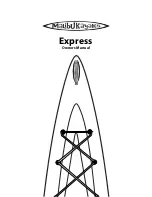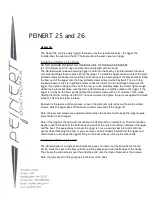
Other parts can be painted with marine paint. Teak (handrails, etc) should be oiled
several times each season. When necessary, the teak parts should be scraped and
sanded. The best and cheapest "teak oil"
i s
a mixture of two parts raw linseed
oil
and one part turpentine thinners.
It can be put on with either a brush
or
a soft cloth.
Excess oil should be wiped off with a cloth moistened with thinners. If you wish to
fix hooks or other fittings to the boat they can either b e screwed or glued on. Fittings
can be screwed t o all wood parts. Holes should b e drilled for screws. Fittings that
do not carry a great load can be screwed on to plastic surfaces with short stainless
steel self tapping screws.
It is very important that the right size holes are drilled first.
A dab of epoxy glue on the threads will provide considerable holding power. Epoxy
glue is so strong that
it
can be used t o glue metal fittings on to the plastic surfaces.
This cannot be done, however, on thermo plastic.
Fittings that have to take a load must b e attached with through bolts. The sandwich
deck will take the load o f such bolts only where the deck is filled with wood
or
spe-
cial filler. If bolts must b e used in other places, the Divinycell filling should b e re-
moved round the hole and glassfibre and resin
or
a polyester putty put to form a
strengthening "tube" round the bolt.
A
piece of wood should be fitted under the
nuts to spread the load. Bolt holes will leak if the bolts are not packed with a rubber
gasket or sealing compound. Glassfibre does not expand when moist, so leaks are
not self sealing as is sometimes the case with a wood boat.
The curtains are cotton and can be washed in water. For the carpets a foam detergent
can b e used. The covers for the matresses are synthetic and may be removed and
dry-cleaned, but it
is
a lot of work to put the covers back again. With a foam detergent
it is possible to wash the covers without removing them. Test the detergent on a spot
on the back side to ascertain that the colour does not face.
Fresh water
The water tank holds
65 litres (14% gals). The deck filler is situated right forward
on the fore deck. The level of the water in the plastic tank can b e checked through
the vertical opening in the bulkhead aft of the tank.
A thin breather pipe which finishes
just under the deck is fitted parallel t o the filling pipe. If the tank is completely filled
the water level will rise up the breather pipe and a small amount of water will find
its way into the bilge; it can be removed easily with the bilge pump.
If
the tank is
completely filled a small amount
of water may also run out into the sink and wash
basin. The tank and supply hoses can be flushed through continued filling of the
tank filling pipe. Water can then run freely through the system, into the sink and
overboard. A large lid is fitted to the tank to facilitate inspection and cleaning. The
forward foot pump in the galley is for fresh water and the aft one for sea water.
Skin fittings and
hose
clips
All skin fittings below the waterline
-
inlet and outlet from the toilet, outlet from the
sink, sea water intake for the galley, and cooling water for the engine have sea
cocks to prevent the water from entering the hull if a hose or pipe should be damaged.
Skin fittings for the exhaust have no sea cocks since they can be reached from deck
and bunged up if need be.
All hose attachements should be checked regularly for leaks and the hose clips
tightened if necessary.
Ventilation and heating
The ventilation system has been designed with scientific thoroughness by a former
chief of Swedish defence research, Hugo Larsson. This is probably the only system
that provides a well ventilated and dry boat without the use of electric fans. O n hot
summer days the temperature inside the boat will b e cooler than that outside.
The system is based on the principle that all fresh air is let into the accommodation
space from deep down in the cockpit. For proper efficiency the cabin doors should
be closed. This air flows down along the inside of the cold hull below the waterline.
The moisture in the air condenses on the cold surface where i t runs down into the
bilges. The dehydrated air is then led t o the fore and aft cabins. Fig. 24. Stale air is
evacuated through three electrolux ventilators which were first developed by Hugo
Larsson for the Vega. These ventilators withdraw air from the cabins whenever there
is any outside air motion over them regardless of direction. With a wind speed of 4
metres per second, approximately
8 knots, one ventilator can suck out 15 cubic
metres of air per hour. The air stream passing up through the ventilators can be
regulated or completely closed off b y a knob (not the toilet ventilator). The starbord
16
www.jonesboatyard.co.uk
















































